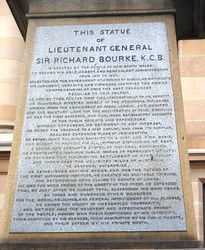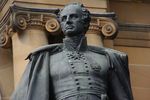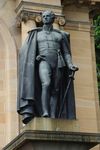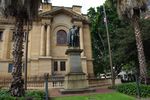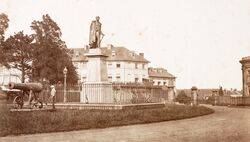
Sir Richard BourkePrint Page 
The statue erected by the people of New South Wales commemorates Sir Richard Bourke`s governorship and administration. This is the first monument erected in Australia.
On 25 June 1831 Sir Richard Bourke was appointed governor of New South Wales and arrived at Sydney on 2 December 1831. Bourke was fortunate in the time of his appointment. He came after an unpopular governor, Sir Ralph Darling. Bourke was the most popular of all the early governors. But he was more than that, his ability and wisdom entitled him to be described as a great governor.
Between 1830 and 1837 the population of New South Wales nearly doubled itself, the revenue was more than trebled, imports rose from £420,480 to £1,297,491 and exports from £141,461 to £760,054. All the credit of this cannot be given to Bourke, but his wise and impartial rule was an important factor in bringing about improved relations among the people and a great increase in general prosperity.
Location
| Address: | Macquarie Street & Shakespeare Place , Outside State Library of New South Wales, Sydney, 2000 |
|---|---|
| State: | NSW |
| Area: | AUS |
| GPS Coordinates: | Lat: -33.866065 Long: 151.212904 Note: GPS Coordinates are approximate. |
Details
| Monument Type: | Monument |
|---|---|
| Monument Theme: | People |
| Sub-Theme: | Government - Colonial |
| Approx. Event Start Date: | 1831 |
| Approx. Event End Date: | 1837 |
| Designer: | E. H. Bailey (London, England) |
| Link: | http://adbonline.anu.edu.au/adbonli… |
Dedication
| Actual Monument Dedication Date: | Monday 11th April, 1842 |
|---|
This statue of Lieutenant General Sir Richard Bourke, K.C.B. is erected by the people of New South Wales to record his able honest and benevolent administration from 1831 to 1837.
Selected for the government at a period of singular difficulty, hHis judgement, urbanity and firmness justified the choice. Comprehending at once the vast resources peculiar to this colony, he applied them, for the first time, systematically to its benefit.
He voluntarily divested himself of the prodigious influence arising from the assignment of penal labour, and enacted just and salutary laws for the amelioration of penal discipline. He was the first governor who published satisfactory accounts of the public receipts and expenditure, without oppression or detriment to any interest, he raised the revenue to a vast amount, and, from its surplus, realized extensive plans of immigration.
He established religious equality on a just and firm basis, and sought to provide for all, without distinction of sect, a sound and adequate system of national education. He constructed various public works of permanent utility. He founded the flourishing settlement of Port Phillip, and threw open the unlimited wilds of Australia to pastoral enterprize.
He established savings banks, and was the patron of the first Mechanic`s Institute. He created an equitable tribunal for determining upon claims to grants of lands. He was the warm friend of the liberty of press. He extended trial by jury after its almost total suspension for many years. By these, and numerous other measures, for the moral, religious, and general improvement of all classes, he raised the colony to unexampled prosperity ; and retired amid the reverent and affectionate regret of the people, having won their confidence by his integrity,
Their gratitude by his services, their admiration by his public talents, and their esteem by his private worth.



